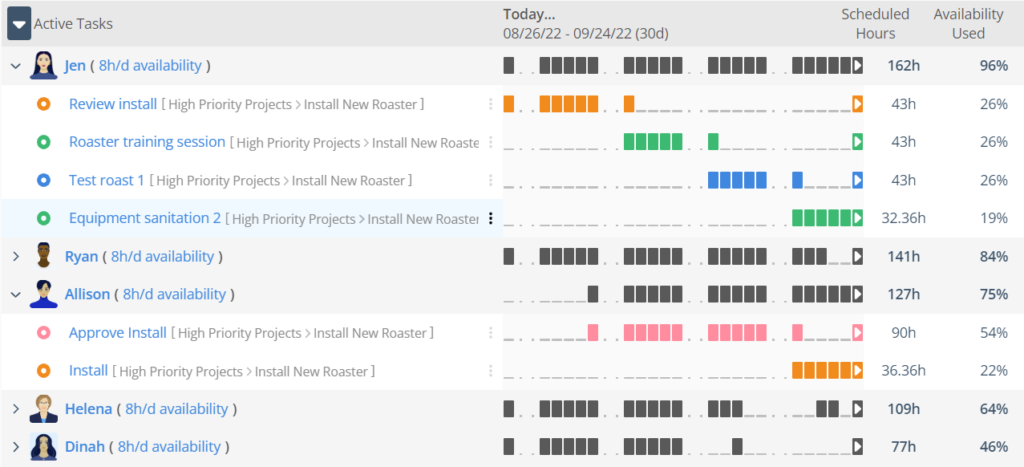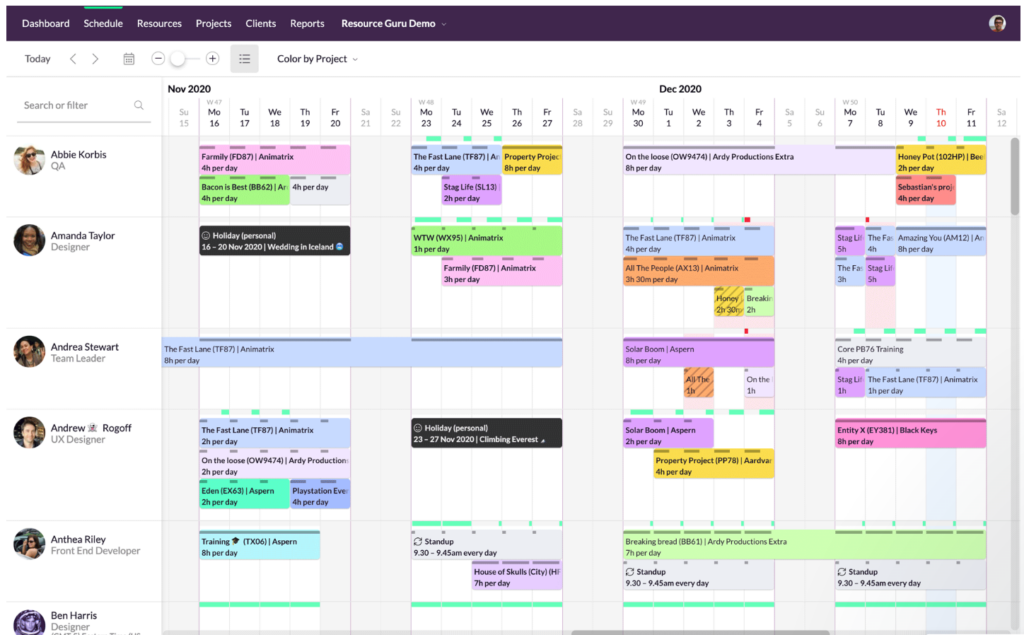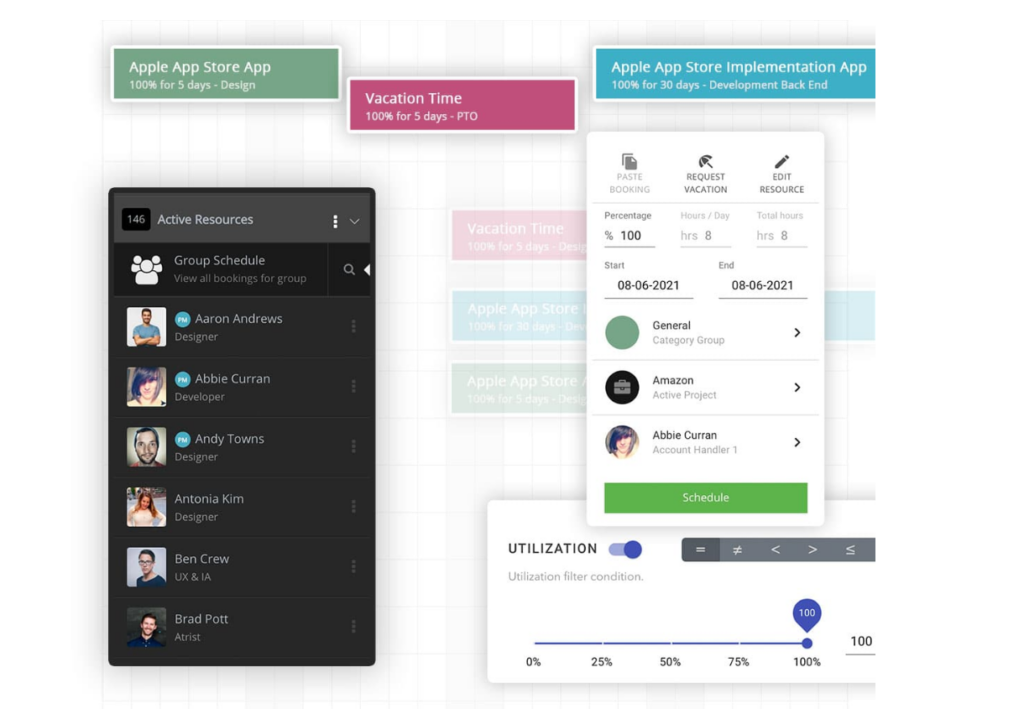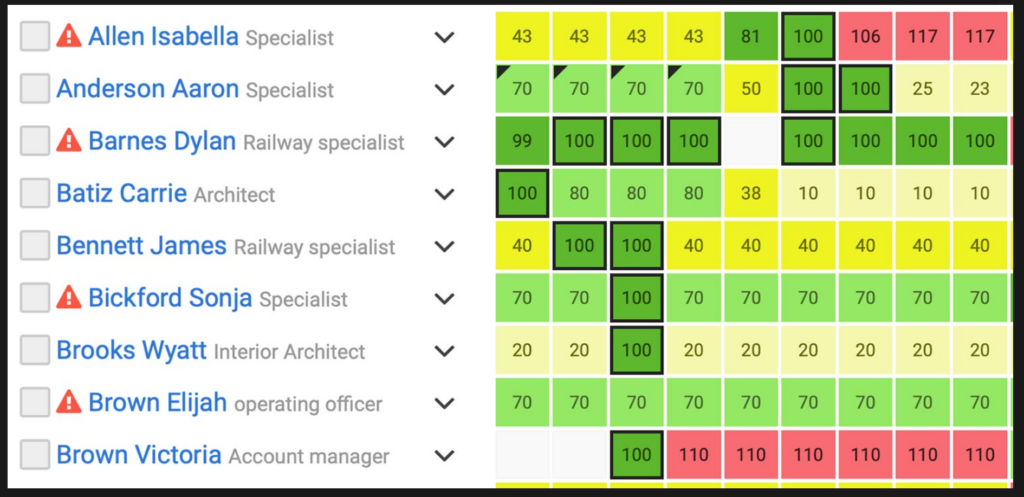Managing your company’s resources including personnel, budget, and other critical resources such as equipment is a complex task for project leaders. Resources are finite and often are shared across many teams. To be a successful project leader, you need to know what resources you have available to complete the job or project in the allotted time and within a constrained budget.
Resource management may often be confused with project management as they heavily overlap. Resource management is typically a support function to project management offices (PMOs). The main purpose of resource management is to ensure the resources required to complete each task are being used most efficiently and readily available to help complete the organization’s top priorities.
These two roles, while sometimes intertwined, can get more complex as disparate teams heavily share company-wide resources. To help keep track of resource availability and utilization to properly plan project timelines, your organization should invest in a resource management tool.
Let’s start by defining resource management software capabilities, key features you may need in the software, and how it could benefit your organization.
What to Know About Resource Management Software
What is ‘Resource Management Software’?
The best resource management software helps companies manage the people, resources, and budget used to carry out a project. It is often referred to as resource planning software or project resource management tools. The solutions include features to effectively plan, schedule, forecast capacity, collaborate and manage tasks of a project.
Project resource management helps project management offices (PMOs) do their work more effectively and efficiently within the timeframe of a project. It also provides organizations with data to allocate resources more efficiently. Whether working remotely or in the office, we are in a world of constant change.The best resource management software solutions can help account for change, keep a balanced workload along the way, and ensure project deadlines are met when scope and priorities inevitably shift. When the cost of working on the wrong thing is too high, resource management software can be the way to go. 
Other types of resource management techniques
Resource management systems can bring order to projects that are demanding, chaotic and hard to track. Because of this, the applications of resource management tools are vast and can be used by all sorts of companies and teams.
Here are some ways resource management systems are used across projects and teams.
-
- Enterprise Resource Planning (ERP): Enterprise resource planning manages and automates the internal processes needed to run a company. This system includes integrative planning, marketing, task management, human resources, sales and purchasing.
- Resource Leveling: This technique balances a project’s schedule based on resource constraints and limitations. One of the goals of resource leveling tools is to identify and maximize underused and overutilized resources within an organization.
- Resource Allocation: Some teams have fewer resources to meet a project’s requirements. Resource allocation is the process of managing, delegating and assigning resources most efficiently and economically.
- Resource Forecasting: Resource forecasting enables teams to plan and predict future demand and incorporate uncertainty before the start of a project. Such software helps teams forecast the scope of a project, constraints, unplanned budgets, and future risks.
- Human Resource Management (HRM): Human resource management is a strategic approach to managing people, your workplace culture, and the environment. It most often involves internal policies, procedures and practices to align workplaces around a business’s objectives and strategic goals.
What resource management does for teams
The best resource management software encourages teams to be more efficient, productive and organized. The software acts as the central location for all of your project needs. As a result, your project team will have more clarity about the priorities with the ability to track tasks and manage progress.
Today, resource planning technology is commonly used for project planning, time management, resource allocation and managing risk. The software offers businesses a central home to streamline tasks, save time, better manage the budget and plan for the right resources.
But it shouldn’t be the only solution to managing projects. PMOs may still need additional collaboration tools (like Google Docs) and have clear internal communication processes to effectively manage work, project scheduling and resource allocation simultaneously.
For these reasons, companies using resource management software for their projects often find success with improved prioritization, workload visibility, and time management.
Essential Resource Management & Planning Features
With the ability to organize your project’s scope, resource management software is capable of doing a lot for your team.
The technology of Resource management software is capable of:
- Prioritizing project work to set realistic expectations with clients, team members and stakeholders
- Planning the project scope and requirements in a centralized hub where people and resources can be managed
- Evaluating who is right for the job, the skills needed to complete the project and to identify which roles are needed to produce the project’s outcomes
- Allocating the right resources to the appropriate project-level priorities
- Maximizing your project scheduling around the right resources with forecasting features
Here are some of the most important features of the software to keep in mind.
1. Project Planning
Project resource planning is the sophisticated process of planning, forecasting, allocating and leveraging your workforce to be efficient. Project planning in resource management software helps to align people and priorities within the project portfolio.
As a result, you can reduce wasted gaps in production for timely project delivery and manage risks ahead of time.
2. Resource Leveling & Workload Management
Getting the priorities and dependencies right can be a huge task when you have the same resources deployed across a number of projects and tasks. In many project management tools, managers can make the mistake of overbooking their teams and resources. This results in too much project work without enough realistic resources to handle it.
You want a solution that keeps it clear and simple for your team. Resource-leveled software can be helpful here. This feature can recalculate your project to produce a more balanced workload when change happens. This may be based on each person’s availability and changes to their task assignments. Resource leveling can help with your project priorities and meet your deadlines on time.
3. Resource Forecasting & Scheduling
Forecasting the scope of a product can be challenging, full of uncertainty, and risky for teams. And because you want to realistically know “When will my project be finished?,” a resource forecasting engine can help you meet deadlines, assess risk and automate schedules.
Predictive scheduling forecasts your start and finish dates in realtime, adapts to change and provides advanced warning if you’re missing your targets. This feature is great for team projects. Every team member can engage with the plan to see their priorities clearly and manage their progress.

Benefits of Resource Management Software
Resource management software should help make your organization much more efficient and productive. But it’s important to find software with as many of the previously listed features as possible to gain maximum efficiency. When you have the right resource management software, you can realize these six benefits.
1. See bandwidth for the entire team across all projects and constraints
Personnel is likely the most valuable asset to any organization. Project leaders must strike the right balance of personnel and equipment resource utilization across the portfolio. To be most efficient, leaders must ensure these resources aren’t being over or underutilized.
When a resource is overutilized, they can then become a bottleneck preventing dependent project tasks from moving forward. Or workers can quickly become burnt out when too many priorities are constantly on their plate. And when a resource is underutilized, efficiencies are lost, and budgets can become quickly constrained.
This is why it is critical for your resource management tool to have the ability to see the 30,000-foot view of resource bandwidth for the whole company across the entire portfolio. This powerful view helps to maximize performance. You can quickly see when one resource becomes a bottleneck before it happens and deploy other resources to balance the workload. This feature is critical to providing the strategic lens to make critical decisions on priority planning and resource allocation.
2. Identify bottlenecks before they occur
Bottlenecks occur when there is not enough capacity of a particular resource to meet the current demands. Some examples include:
- The same equipment is utilized by disjointed departments
- Departments don’t have visibility into the availability of shared resources
- Lack of investment in better equipment or more personnel
- Equipment repairs caused unplanned downtime
- Unexpected leave of absence of personnel
- Increase in demand of goods or services
When one resource is at capacity while other resources in succession are underutilized, this quickly creates a backlog of WIP inventory or underutilized time for workers. This single bottleneck can create organization-wide inefficiencies. Resource management software can identify these bottlenecks before they occur so you can reallocate resources across the portfolio.
3. Avoid unbalanced workloads
When employees constantly have too many priorities, they will inevitably become burnt out. The constant stress of having too much work and insufficient time to finish it all can heavily contribute to
- Increased turnover. It can take many months to hire and fully train someone to replace personnel. This wastes valuable company time and money to onboard a new associate, not to mention lost productivity.
- Declining performance. Working under constant stress affects employees’ mood and emotional well-being, which inevitably affects job performance. Concurrently, underutilization can cause workers to disengage and be less productive.
- Increased errors. When workers have too many tasks to juggle, it’s much easier to make small mistakes that could cause the company much more money in the long run.
Resource management software allows you to avoid unbalanced workloads before they happen.

4. Avoid inter-departmental politics with resource allocation
Have you ever needed to compete for resources inside your organization? It can create a hostile workplace dynamic if disjointed teams need to fight for resources against their peers. When leaders don’t take a portfolio approach to planning, teams waste valuable time and energy competing for resources. This approach creates multiple competing teams inside of an organization instead of acting as one big team.
By taking a portfolio approach to planning, leadership takes away the stress by prioritizing finite resources across disjointed teams. Resource management software allows leaders to be clear about organization-wide priorities, so everyone in the organization is rallied behind the top priority. This allows teams to avoid unnecessary lost productivity due to the politics of fighting for shared resources.
5. Scenario plan before making decisions
Have you ever realized after the fact that your team doesn’t actually have the capacity to take on that new project? One major benefit of resource management software is the ability to see if your team can take on that new project quickly and easily. This strategic lens can help you make go/no-go decisions more confidently with scenario planning.
Some resource management tools don’t automatically update timelines when priorities shift. Without this feature, it becomes much more difficult to scenario plan. Be sure to find a resource management tool that allows you to drag and drop projects to change their priority order to see how that affects project timelines across the portfolio to fully realize this important benefit.
6. Discover insights to increase productivity
Resource management software should provide insights you may not have uncovered otherwise. Some examples of insights you can gain with resource management software include:
- Use past performance to estimate future timelines better
- Increase utilization rates
- Review performance metrics in real-time
- See risks to the timeline before they occur
A major part of a project leaders role is to ensure a project’s timeline is on track and that the team is staying within budget. Resources management software allows leaders to quickly view their dashboards to monitor and improve performance and make changes to utilization rates quickly and easily. By looking at past performance quickly, leaders can discover ways to improve cost savings and increase worker productivity.
These six benefits are what you should expect to find in your resource management software. If your current resource management solution doesn’t provide all six of these benefits, then check out our short list of the best resource management tools on the market in 2022 below.
Top 10 Best Resource Management Software
Now you know exactly what benefits resource management software can bring to your organization and the features you need in a tool to realize these benefits. Below is the list of the best Resource Management solutions for project & portfolio management on the market, covering their signature features, customer sentiments and pricing.
#1 LiquidPlanner

LiquidPlanner is a portfolio planning and resource management solution built to help teams plan, predict and perform with confidence. LiquidPlanner’s unique predictive scheduling engine is fully integrated with its robust resource management features. When priorities shift, scope changes or resource allocations are made, the scheduling engine automatically updates user assignments and schedule dates in real-time. LiquidPlanner does real automatic resource leveling across the entire project portfolio, and eliminates both overload and underload to ensure the organization’s most effective use of resources. LiquidPlanner’s workload views provide a bird’s eye view of capacity for all resources across all projects and constraints in the portfolio, revealing resource bottlenecks early and opportunities to go faster.
Top Features:
- Automatic resource leveling (across multiple projects & constraints for a balanced workload)
- Scheduling updates in real-time as resources and priorities shift
- Capacity, utilization & billable rates for every resource and all projects
- Priority-based alignment for resourcing decisions
- Real-time insight to bottlenecks & risk
- All-in-one project and resource management integrated solution
Directly from the customer: Lindsey from Victualic says “LiquidPlanner uniquely uses effort and resource prioritization to drive expected dates that ultimately addressed our issue of shared, constrained resources. Other software highlighted potential issues, but no other solution showed the impact and gave information on how to resolve the conflict”
Pricing: LiquidPlanner offers four plan options to meet a variety of customer needs; FREE plan, Essentials Plan ($15 / per user / per license), Professional Plan ($25 / per user / per license) and the Ultimate Plan ($35 / per user / per license).
#2 Kantata Cloud for Professional Services

The Kantata Cloud for Professional Services offers a core operating environment for resource management, financial management, project management, team collaboration, business intelligence, integration, and workflow automation functionality that optimizes resources and elevates operational performance. Kantata also provides dashboards for time and expense tracking features.
Top Features:
- Resource Allocation (across multiple projects and portfolios)
- Capacity forecasts by role
- Resourcing by skill for informed project staffing
- Integrated financial management to track cost & boost margins
- Distinguish between soft and hard resource allocation
Directly from the customer: Jane Everett Goering, Resource Manager says “Being able to have this ecosystem with Kantata where we could look at our resources as a whole and see where they were deployed, what skill sets we had available and balance out the workload was a huge opportunity.”
Pricing: Kantata’s pricing is not published, but you can get custom quotes based on your industry and company size.
#3 Float

Float is the resource management software that keeps teams of 5 to 5000+ in sync. Float allows you to schedule tasks quickly with a real-time view of availability, including time off and public holidays. It provides views of your team’s capacity and utilization at a glance to optimize assigned work. You can connect with project management, calendar, and communication workflows via direct integrations to keep project plans up to date with easy bulk edits.
Top Features:
- Resource scheduling & availability management
- Time tracking to compare estimates vs. actuals (on the Resource Planning + Time Tracking plan)
- Capacity management that accounts for vacations
- Set budgets and target milestones
- Utilization reports & forecasting
Directly from the customer: Leah Zeis, Post Production Manager says “With 100+ projects on the go, Float gives us a high-level view of our resource capacity to schedule the right team for the job.”
Pricing: Float offers two simple plans; Resource Planning ($6 / per person / per month) and Resource Planning + Time Tracking ($10 / per person / per month)
#4 Resource Guru

Resource Guru is a project scheduling and leave management calendar system that offers a fast and flexible way to keep projects on track. It allows you to assign work, balance schedules, and track team availability and time off to avoid unrealistic workloads. Resource Guru connects to other calendars and keeps your team up-to-date with personal dashboards and daily schedule emails. You can manage people, equipment, and meeting rooms in one place. Analyze utilization rates across projects and clients for more accurate forecasting.
Powerful reports show utilization rates, billable vs. non-billable time, overtime, holiday and other time off.
Top Features:
- Bird’s eye capacity views (filtered by capacity by skill, department & location)
- Drag and drop to rebalance workloads
- Unique “clash management” for resource conflicts
- Centralized resource pool and employee directory
- Project forecasting and resource utilization reports
Directly from the customer: From Matias C., Senior Video Editor “Easy to get a birds-eye view to see how the teams is managing projects, check who is handling too much, who is light on work and how forthcoming vacations mix in the monthly workload. I love the integration with Google Calendars and Outlook.”
Pricing: Resource Guru offers three pricing plans: Grasshopper Plan ($2.50 / per person / per month), Blackbelt Plan ($4.16 / per person / per month) and the Master Plan ($6.65 / per person / per month).
#5 Resource Management by Smartsheet

Resource Management by Smartsheet is a high-level project and resource management software that helps teams make confident decisions about project planning, team capacity, budget forecasting, team utilization, and hiring needs in real time. Smartsheet’s resource planning tool gives you visibility to schedule to manage your team effectively, update the availability on the fly, and immediately see the impact on the project’s budget.
Top Features:
- Simple resource allocation methodology
- Easy time tracking tied in with resourcing
- Resource utilization and staffing forecasts
- Skills database for project matching
- Ability to integrate with Smartsheet
Directly from the customer: From Julie M., Small Business: “I am impressed with the usability, ease, and ability to make our resource management as detailed as we want or need, or it can be elementary for some needs. I like that it gives us the flexibility to adapt the tool to our ever-changing business needs. What we need today could change at the drop of a hat, and SmartSheet Resource Management is the go-to in any scenario!”
Pricing: Resource Management by Smartsheet’s basic plan starts at $25/user/month.
#6 Hub Planner

Hub Planner is an online resource management, team scheduling, time tracking, and project planning software. It is a comprehensive platform that combines several important functionalities under a single location that is easy to use, smart, and intuitively designed. Hub Planner offers a complete solution for small, medium and enterprise-level business, to helps you make the move from cumbersome spreadsheets to a fully fledged team resource scheduling and project planning tool. Hub Planner also boasts real-time insightful information with analytic reports and dashboards.
Top Features:
- Schedule your team across multiple projects
- Bird’s eye view of your resource’s availability and allocaation
- Report on actual vs scheduled time
- Report on spend and utilization
Directly from the customer: From Fika Town: “We wasted so much time trying to do our resource planning in Spreadsheets. Hub Planner has now created so much transparency and clarity in our resource and project schedule.”
Pricing: Hub Planner offers three pricing plans: Plug & Play ($7 / per resource / per month), Premium ($18 / per resource / per month) and the Enterprise plan (contact Hub Planner for details)..
#7 Forecast

Forecast is a full-suite platform for improving the operational and financial performance of professional service companies by uniting project management, resource management, finance & billing, time tracking, and business intelligence in one AI-powered software. Perfect for companies of 50+ employees who want the full project portfolio and resource overview in one software solution.
Top Features:
- Real-time overview of the workload and capacity
- Monitor over or under allocations
- AI for easier time tracking
- Resource utilization data for the entire portfolio
Directly from the customer: From Dan B., COO: “Forecast brings everything a growing agency needs in a single all-in-one solution. Manage projects, resource and availability alongside utilisation, invoicing and future forecasted revenue. Perfect!”
Pricing: Forecast offers three pricing plans: Lite ($29 / per seat / per month), Pro ($49 / per seat / per month) and the custom Plus plan.
#8 Retain Cloud

Retain International is a leader in resource planning software for businesses of all sizes, focused on improving efficiency with cost-effective and flexible solutions to allow firms to manage their resources effectively. With a complete overview of current clients, projects and staff, organizations can ensure they are operating at optimum efficiency and improve profitability with Retain.
Top Features:
- Manage resources across multiple teams
- Leverage skills across location & time zones for faster demand fulfillment
- Real-time view of all your resources
- Track billable utilization
- Enhance planning with scenario modeling.
Directly from the customer: From Tanya R., Workflow & Resource Manager: “Retain is the resource management tool I needed to be proactive in planning and forecasting staffing solutions. My favourite part is the view in plans. Being able to see all the staff jobs planned on a calendar is what led me to decide to implement Retain at my firm rather than other resource management software. The Skills feature is allowing a small firm like FK to hone in on Staff’s skills and thus finding the perfect “fit” when staffing a job using this feature.”
Pricing: Retain Cloud offers three pricing plans: Expanding (£10 / per user / per month), Entrepreneur (£13 / per seat / per month) and Enterprise (Bespoke).
#9 Silverbucket

Silverbucket is a project resource management software that compares planned hours to actuals. With Silverbucket’s user-friendly resourcing tool, you can make resource plans easily and get a clear view of a company’s resource allocations. It provides visibility into conflicts, workload, and capacity level conveniently in one view. You’ll no longer need to guess about resource management’s current or future situation.
Top Features:
- One clear resourcing overview
- Company, team and individual workloads
- Capacity planning
- Clear views into resource conflicts
Directly from the customer: From Pirkka L., Head of Customer Success “Silverbucket user interface is intuitive and straightforward. Making the resource allocation and changing them is very simple and easy to use. Basic use of the solution is easy to learn. The most critical data is available over the APIs. Hour logging is really simple and easy to use.”
Pricing: Starting at 7.5 € / planned person / month
#10 Monday.com

Monday.com is a flexible platform to help teams communicate in context and get a birds-eye view of outstanding projects, available resources, and projected timelines. Monday.com’s smart design and straightforward interface mean teams can start planning timelines, assigning project ownership, and managing any project in minutes.
Top Features:
- Large number of integrations
- Ability to create kanban boards focused to operational resource tracking
- Color-coded status great for resource overviews
Directly from the customer:
Pricing: Monday.com offers five pricing plans: Free, Basic ($8 / per seat / per month), Standard ($10 / per seat / per month), Pro ($16 / per seat / per month) and the Enterprise plan.
Summary
Many resource management solutions are available, each with its niches and competitive advantages. It’s important to consider what your team is missing from your current resource management solution, or if you don’t have one, to clearly define the features and functionality most critical to your organizational success. Include multiple stakeholders from your entire organization that would benefit from using the resource management software. It’s this level of partnership across your organization that will allow you to select the resource management tool that is most effective for all relevant stakeholders.
Remember, as you’re testing out various resource management solutions, be sure to remember the list of the most important benefits you should be realizing from the use of the tool. These include:
- See bandwidth for the entire team across all projects and constraints
- Identify bottlenecks before they occur
- Avoid unbalanced workloads
- Scenario plan before making deci
- Avoid inter-departmental politics with resource allocation
- Discover insights to increase productivity
While you may consider price to be a crucial factor, it’s critical to remember the price savings that will come with a fully-fledged resource management tool. Be sure that your organization is not making a decision based heavily on price, as that may cost your organization more money in the long run.
Use this guide as a reminder to select the best resource management software. Your goal should be to find a resource management solution that encourages teams to be more efficient, productive and organized. Pick the software that can act as the central location for your project needs. Your project team will ultimately have more clarity about the priorities with the ability to track tasks and manage progress with the right tool.







